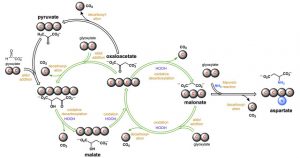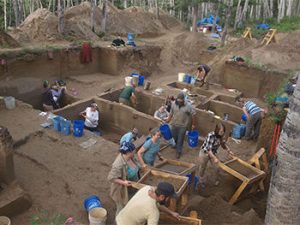This month there have been several news items concerning discoveries about ancient life that I’d like to spend a little time discussing. The research spans the whole history of life here on earth from it’s very beginning to just before the start of recorded history. I think I’ll start at the beginning and work my way forward in time.
The first story is actually an update or perhaps I should say progress report on the work being done at The Scripps Research Institute (TSRI) into the chemical processes that literally came to life almost four billion years ago. In my post of 11Nov17 I described how a team of chemists led by Doctor Ramanarayanan Krishnamurthy at TSRI had discovered that a catalyst called diamidophosphate or DAP could have provided a means for the three basic chemical groups of life, nucleic acids, proteins and lipids to have come together into a single pre-living cellular structure.
Now Dr. Krishnamurthy and his team have gone further, focusing on the chemical reactions that provide energy for cells, the citric acid cycle. Modern living organisms use the citric acid cycle to release the energy stored in sugars and fats. However the chemical components necessary for the critic acid cycle probably did not exist on the early Earth.
What the scientists have now done is to show that two non-biological cycles, the HKG cycle and Malonate cycle could have worked together to accomplish the same metabolic function as the citric acid cycle. Then, as more efficient biological catalysts became available HKG and Malonate could have been replaced by citric acid while leaving the basic structure of the cycle in place. As Doctor Greg Springsteen of Furman University and a co-author of the study stated, “Modern metabolism has a precursor, a template, that was non-biological.” How the HKG/Malonate cycle would work is detailed in the image below.

Now I took two courses in organic chemistry as an undergraduate and I do remember learning a bit about the critic acid cycle but I freely admit some of this stuff is over my head. However, if you’d like to learn more about the research going on at the Scripps Institute click on the link below to be taken to their website.
https://www.scripps.edu/news/press/2018/20180108krishnamurthy.html
The next article also deals with early life but a good deal more advanced than that which is being studied at TSRI. In fact the fossils in the study represent the earliest known multi-cellular creatures, organisms that also used photosynthesis and engaged in sexual reproduction. The fossils themselves were collected more than twenty years ago from Somerset and Baffin Islands in Canada but their dating had been in question from their first description. A range of possible dates stretched from 720 million to 1.2 billion years ago which could either make the fossils nothing special or much too advanced for anyone to believe.
The study by researchers at McGill University used new radio-chemical dating techniques to narrow the possible age of the fossils to between 1.03 and 1.06 billion years old, an age that excites paleontologists without giving them a heart attack. The image below shows some of the fossils, which have been given the name Bangiomorpha pubescens because it resembles the modern red algae bangio.

In the image the fossils obviously are multi-cellular and in the image at bottom right asexual spores can be seen. In other examples sexual spores have also been found making Bangiomorpha pubescens the earliest known example of a sexually reproducing species.
My final discovery is much more recent in age and deals with human migration into the Americas. Excavations at the Upward Sun River archaeological site in Alaska have unearthed the remains of an infant girl that have been dated to 11,500 years ago. Preserved by the cold the remains were in such good condition that a genetic analysis was possible. The DNA analysis revealed that the girl belonged to a previously unknown, ancient group of people. The image below shows some of the dig site.

“These are the oldest human remains ever found in Alaska,” says Professor Eske Willerslev of the Universities of Cambridge and Copenhagen. Prof. Willerslev adds that the girl came from “a population that is most closely related to modern Native Americans but is still distantly related to them. So, you can say that she comes from the earliest, or most original Native American group.”
Scientists hope that further studies of the remains along with all of the material finds at the Upward Sun River site will reveal more about how the Americas were first settled and by what kind of people.
